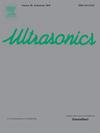Utilization of fullerenes nanoparticles for ultrasound applications in developing a high-efficiency acoustic emission source
IF 3.8
2区 物理与天体物理
Q1 ACOUSTICS
引用次数: 0
Abstract
Fullerenes have exhibited excellent performance in solar cells, electric transducer and catalysts. The rather high absorption coefficient, combined with its low specific heat capacity, as well as hydrophobicity and antioxidant, are key features for applications in acoustic emission (AE), which has never been reported. Here, we fabricate and characterize a flexible an AE source based on the fullerenes-polydimethylsiloxane (PDMS) composite. By controlling the composite concentration or thickness, the center frequency can be changed in laser ultrasound excitation. The assembled transducer simultaneously achieves relatively wide frequency range (10-dB bandwidth10 MHz) and efficient laser ultrasound conversion . The mechanical robustness of the AE source is also quantitatively characterized in water. Notably, compared to graphene nano-flakes, the fullerenes exhibit a more than threefold increase in excitation amplitude. Owing to high-intensity ultrasound excitation of the fullerenes-PDMS composite, the structure characteristics of centimeter-scaled physical models are clearly resolved by irradiating the material as a laser-ultrasound source. To construct a compact fiber-optic exciter, the fullerenes-PDMS film is additionally applied to a fiber end via dip coating. The findings suggest that fullerenes possess significant competitive advantages as a high-efficiency AE source in the field of ultrasound applications.
利用富勒烯纳米颗粒在超声领域的应用开发了一种高效声发射源
富勒烯在太阳能电池、电换能器和催化剂等方面表现出优异的性能。其较高的吸收系数、较低的比热容以及疏水性和抗氧化性是其在声发射(AE)领域应用的关键特征,但这方面的研究尚无报道。本文以富勒烯-聚二甲基硅氧烷(PDMS)复合材料为材料,制备并表征了一种柔性声发射源。通过控制复合材料的浓度或厚度,可以改变激光超声激发的中心频率。组装的换能器同时实现了相对较宽的频率范围(10 db带宽>;10 MHz)和高效的激光超声转换(1.13×10−2)。在水中,声发射源的机械鲁棒性也得到了定量表征。值得注意的是,与石墨烯纳米片相比,富勒烯的激发振幅增加了三倍以上。由于富勒烯- pdms复合材料的高强度超声激发,通过激光-超声源照射材料,可以清楚地分辨出厘米尺度物理模型的结构特征。为了构建紧凑的光纤激振器,将富勒烯- pdms薄膜通过浸渍涂层附加在光纤端部。研究结果表明,富勒烯作为一种高效声发射源在超声应用领域具有显著的竞争优势。
本文章由计算机程序翻译,如有差异,请以英文原文为准。
求助全文
约1分钟内获得全文
求助全文
来源期刊

Ultrasonics
医学-核医学
CiteScore
7.60
自引率
19.00%
发文量
186
审稿时长
3.9 months
期刊介绍:
Ultrasonics is the only internationally established journal which covers the entire field of ultrasound research and technology and all its many applications. Ultrasonics contains a variety of sections to keep readers fully informed and up-to-date on the whole spectrum of research and development throughout the world. Ultrasonics publishes papers of exceptional quality and of relevance to both academia and industry. Manuscripts in which ultrasonics is a central issue and not simply an incidental tool or minor issue, are welcomed.
As well as top quality original research papers and review articles by world renowned experts, Ultrasonics also regularly features short communications, a calendar of forthcoming events and special issues dedicated to topical subjects.
 求助内容:
求助内容: 应助结果提醒方式:
应助结果提醒方式:


